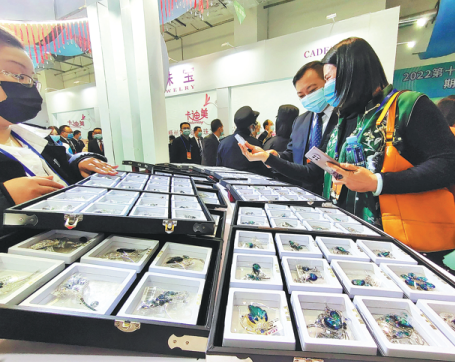Wuzhou adds to luster as synthetic gems hub

A visitor checks out synthetic gems at the 18th Wuzhou Jewelry Show and Festival in Wuzhou, Guangxi Zhuang autonomous region, in December 2021. YANG ZHIXIONG/CHINA NEWS SERVICE
Editor's note: This series of stories looks at local enterprises in specialized sectors that have a share in global markets.
Like many of his fellow workers, Cen Jiantu chose one of the city's highest-paying sectors — the synthetic gems industry — when he entered the job market two decades ago.
The sector "offered the best prospects", the 39-year-old gem cutter said. "We could each earn 500 yuan ($70) to 600 yuan a day back then, which is what some migrant workers in other jobs would make in a month."
The reputation of Wuzhou, a city in South China's Guangxi Zhuang autonomous region, as the global hub of synthetic gems remains as bright as ever.
Synthetic gems are lab-made stones that look and feel like their natural counterparts, such as diamonds, rubies and emeralds, but at a fraction of their price. The industry rolled out in Wuzhou four decades ago, leveraging the city's comprehensive logistics network, ample labor supply and other advantages.
"Our stones can contain fewer flaws than natural gems. Our moissanite products, for example, can be more brilliant than diamonds," said Huang Jinjun, general manager of Wuzhou Holycome Jewelry. Moissanite is a naturally occurring and laboratory-grown mineral used as a diamond alternative.
Now, thanks to technological advances and improved materials, Wuzhou is poised to reach a new level of success, according to industry insiders.
"This is a technology-based sector," Huang said. "Our improvements in machinery and materials helped reduce costs. That means the market, with prices that can be 10 percent of what they used to be, is at the optimal attraction level, taking the industry to new heights."
Wuzhou is home to 70 percent of global synthetic gemstone production. The number of stones processed, distributed and traded in the city last year exceeded 100 billion, with the comprehensive output value reaching about 10.7 billion yuan, according to the latest industry figures.
Jiang Liangqiong, director of the city's gemstone industry development center, said that "from simple processing to the establishment of machinery-led factories, from dependence on raw materials and equipment imports to industry localization and international trade, Wuzhou has become the world's largest synthetic gemstone processing base".
"In recent years, with the advancement of science and technology fueling the increase in lab-grown products, the popularity of synthetic gemstones continues, with enterprises' inventories striving to meet demand," she said.
With young consumers forming a major segment of the market, there are "unprecedented new opportunities for the development of synthetic gemstones offering competitive prices and high quality", Jiang said.
Policy support for small and medium-sized enterprises, in exploring the international market, pursuing product certification, obtaining overseas patents and trademark registration, establishing research and development, and training talent, will help the industry grow further, Jiang said.
The sector has also seen significant improvements in green, sustainable production with improved technology, reducing any environmental impact, she said.
"We continue to minimize any water, noise and other forms of pollution. The challenge now is to keep upgrading our production, processes and management. The public and private sectors can work together to further meet international industry standards," Jiang said.
Wuzhou Mayor Zhong Changzi said the city is rolling out a gemstone industrial park to improve support for related services, help guide enterprise development, enhance technological innovation, product innovation capabilities and quality, and create leading local brands.
"With the diversification of consumer demand, the rise of new retail business models and the gradual emergence of millennials as a major force of China's consumer market, synthetic gemstones will usher in new opportunities for development," she said.
Rao Guiqiang, who is in charge of Xuping Jewelry's Wuzhou operations, said the city is well-placed at the center of the industry.
"We supply to the world through our major distribution channels via cities like Hong Kong and Shanghai," said Rao, whose group exports about 300 million gems every year to 100 countries and regions.
"We meet demand according to all specifications. From wholesale buyers to fashion designers, everyone in the industry, at home and abroad, gets drawn here. We're certainly looking at a new high," he said.
Zhong, the Wuzhou mayor, said that efforts must be made to take advantage of "major strategic opportunities" offered by countries participating in the Regional Comprehensive Economic Partnership agreement, the world's largest free trade pact, and the Belt and Road Initiative, and to "vigorously develop cross-border e-commerce and extend overseas sales channels".
Huang, the Wuzhou Holycome Jewelry general manager, said digital forays into areas such as e-commerce and livestreaming to complement traditional industry exhibitions will form an "online-offline combination that can help Wuzhou take up to 90 percent of the global market".
Those prospects bode well for Cen, the gem cutter, who has trained and managed more than 100 specialists in five factories in the city.
It takes at least three to four years for each of these specialists to learn the basics of the trade and to achieve the perseverance, patience, steady hands and keen eyes needed for cutting, polishing and finishing products.
"We have very good machinery now to help us, but experience and expertise are still paramount in producing a gem that shines flawlessly," he said.
